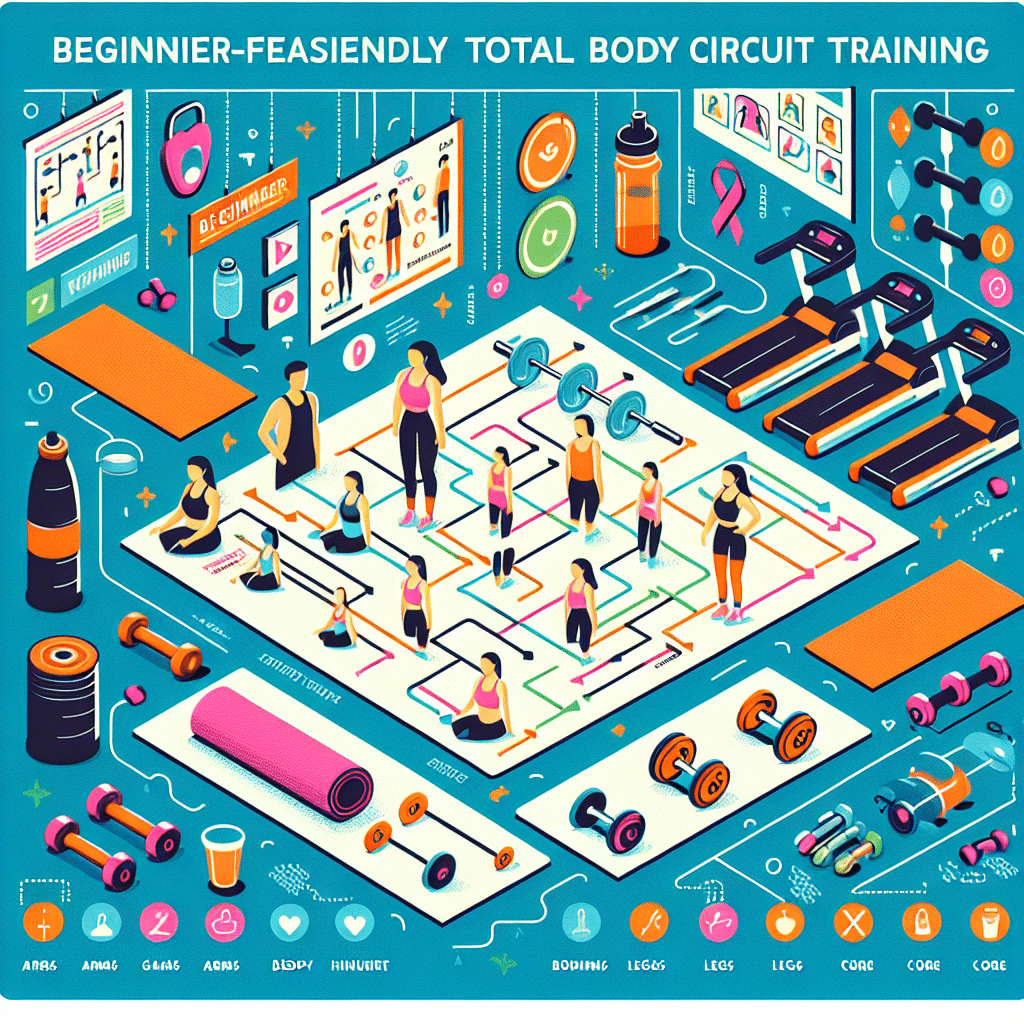Circuit training is an effective way to get fit, combining strength training, cardio, and flexibility into one workout session. This beginner-friendly total body circuit workout emphasizes simplicity while offering a comprehensive regimen that can fit seamlessly into your busy schedule. The workout includes a variety of exercises that target all major muscle groups, ensuring a balanced approach to fitness.
What is Circuit Training?
Circuit training involves performing a series of exercises in succession, with minimal rest in between. This approach not only improves muscular endurance and strength but also promotes cardiovascular health. It allows beginners to engage multiple muscle groups and increase the heart rate for a full-body workout.
Benefits of Circuit Training for Beginners
-
Time-Efficient: Circuit training typically requires less time compared to traditional weightlifting routines. You can achieve a full body workout in just 30 to 45 minutes.
-
Adaptable: Beginners can adjust the intensity of each exercise, making circuit training suitable for all fitness levels.
-
Variety: With a wide range of exercises, circuit training helps prevent boredom and keeps motivation high.
-
Improved Cardiovascular Health: The combination of strength and cardio exercises increases heart rate, promoting cardiovascular fitness.
-
Muscle Activation: Engaging multiple muscle groups leads to improved strength and muscle tone.
Total Body Circuit Workout Plan
The following circuit can be performed 2 to 3 times a week. Each exercise should be done for 30 seconds, followed by 15 seconds of rest, before moving on to the next exercise. After completing all exercises, rest for 1 to 2 minutes and repeat the circuit for a total of 2 to 3 rounds.
Warm-Up (5-10 Minutes)
Always begin with a dynamic warm-up to prepare your body. Perform each of the following exercises for 30 seconds:
-
Arm Circles: Stand tall and extend your arms out to the side. Make small circles, gradually increasing the size.
-
Leg Swings: Hold onto a wall or sturdy surface for support, swing one leg forward and backward. Alternate legs after 30 seconds.
-
High Knees: Jog in place, bringing your knees up towards your chest as high as possible.
-
Bodyweight Squats: Stand with feet shoulder-width apart. Lower your body as if you’re sitting in a chair, keeping your chest up and back straight.
Circuit Exercises
1. Bodyweight Squats
- Target: Quadriceps, hamstrings, glutes.
- How to Perform: Stand with feet hip-width apart. Lower your body by bending your knees and pushing your hips back, maintaining a straight back. Return to the starting position and repeat.
2. Push-Ups
- Target: Chest, shoulders, triceps.
- How to Perform: Start in a plank position with hands slightly wider than shoulder-width. Lower your body until your chest nearly touches the floor. Push back to the starting position. Beginners can perform these on their knees.
3. Bent-Over Dumbbell Rows
- Target: Back, biceps.
- How to Perform: Hold a dumbbell in each hand, bend your knees slightly, and hinge at the hips, keeping your back straight. Pull the weights towards your torso while squeezing the shoulder blades together. Lower and repeat.
4. Standing Overhead Dumbbell Press
- Target: Shoulders, triceps.
- How to Perform: Stand with feet shoulder-width apart, holding a dumbbell in each hand at shoulder height. Press the weights overhead until your arms are fully extended. Lower back down and repeat.
5. Plank Hold
- Target: Core, shoulders, back.
- How to Perform: Start in a push-up position. Keep your body in a straight line from head to heels. Hold this position, engaging your core muscles.
6. Alternating Lunges
- Target: Glutes, quads, hamstrings.
- How to Perform: Stand tall and step forward with your right leg, lowering your body until both knees are at 90-degree angles. Return to starting position and switch legs.
7. Bicycle Crunches
- Target: Core, obliques.
- How to Perform: Lie on your back with your hands behind your head. Lift your knees to a 90-degree angle. Bring your right elbow to your left knee while extending the right leg, then switch sides.
8. Jumping Jacks
- Target: Full body, cardio.
- How to Perform: Stand with feet together and arms by your sides. Jump up, spreading your feet and raising your arms overhead. Return to the starting position and repeat.
Cool Down (5-10 Minutes)
Cooling down is essential to help your body transition back to a resting state. Follow these stretching exercises:
-
Forward Fold: Stand with feet together, bend forward at the hips, and reach for your toes. Hold for 20-30 seconds.
-
Shoulder Stretch: Bring one arm across your chest and hold it with the opposite arm, feeling the stretch in your shoulder. Switch sides after 20-30 seconds.
-
Hip Flexor Stretch: Kneel on one knee with the other foot in front, forming a 90-degree angle. Push your hips forward to stretch the hip flexor of the kneeling leg. Switch sides.
-
Child’s Pose: Kneel on the floor, sit back on your heels, and stretch your arms forward while lowering your chest. Hold for 20-30 seconds.
-
Cat-Cow Stretch: On all fours, alternate between arching your back towards the ceiling (cat) and lowering your belly while lifting your head and tailbone (cow).
Final Considerations
When starting with any workout program, it’s essential to listen to your body and proceed at your own pace. Ensure proper form during exercises to avoid injury, and consider consulting with a fitness professional if you are unsure about any movements.
Staying hydrated, maintaining a balanced diet, and getting ample rest are also crucial components of a successful fitness regimen. As you grow more comfortable with these exercises, consider increasing the duration or intensity of your workouts to continue progressing.
With consistency and dedication, this total body circuit workout can be an effective way for beginners to get fit and develop a healthier lifestyle.
